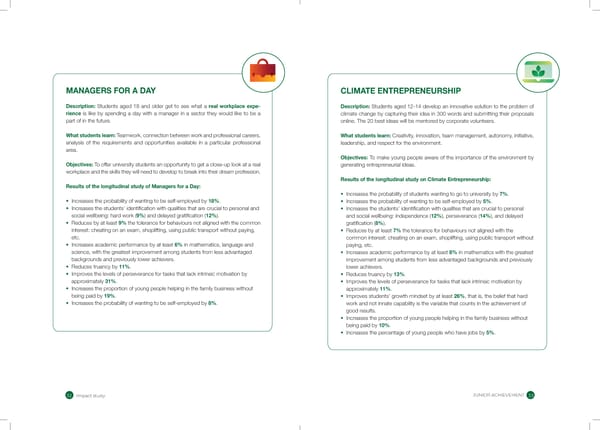MANAGERS FOR A DAY CLIMATE ENTREPRENEURSHIP Description: Students aged 18 and older get to see what a real workplace expe- Description: Students aged 12-14 develop an innovative solution to the problem of rience is like by spending a day with a manager in a sector they would like to be a climate change by capturing their idea in 300 words and submitting their proposals part of in the future. online. The 20 best ideas will be mentored by corporate volunteers. What students learn: Teamwork, connection between work and professional careers, What students learn: Creativity, innovation, team management, autonomy, initiative, analysis of the requirements and opportunities available in a particular professional leadership, and respect for the environment. area. Objectives: To make young people aware of the importance of the environment by Objectives: To offer university students an opportunity to get a close-up look at a real generating entrepreneurial ideas. workplace and the skills they will need to develop to break into their dream profession. Results of the longitudinal study on Climate Entrepreneurship: Results of the longitudinal study of Managers for a Day: • Increases the probability of students wanting to go to university by 7%. • Increases the probability of wanting to be self-employed by 18%. • Increases the probability of wanting to be self-employed by 5%. • Increases the students’ identi cation with qualities that are crucial to personal and • Increases the students’ identi cation with qualities that are crucial to personal social wellbeing: hard work (9%) and delayed grati cation (12%). 12%), perseverance (14%), and delayed and social wellbeing: independence ( • Reduces by at least 9% the tolerance for behaviours not aligned with the common grati cation (8%). interest: cheating on an exam, shoplifting, using public transport without paying, • Reduces by at least 7% the tolerance for behaviours not aligned with the etc. common interest: cheating on an exam, shoplifting, using public transport without • Increases academic performance by at least 6% in mathematics, language and paying, etc. science, with the greatest improvement among students from less advantaged • Increases academic performance by at least 8% in mathematics with the greatest backgrounds and previously lower achievers. improvement among students from less advantaged backgrounds and previously • Reduces truancy by 11%. lower achievers. • Improves the levels of perseverance for tasks that lack intrinsic motivation by • Reduces truancy by 13%. 31%. approximately • Improves the levels of perseverance for tasks that lack intrinsic motivation by • Increases the proportion of young people helping in the family business without 11%. approximately being paid by 19%. • Improves students’ growth mindset by at least 26%, that is, the belief that hard • Increases the probability of wanting to be self-employed by 8%. work and not innate capability is the variable that counts in the achievement of good results. • Increases the proportion of young people helping in the family business without being paid by 10%. • Increases the percentage of young people who have jobs by 5%. JUNIOR ACHIEVEMENT ׁ׀٪ Impact study ׁׁ
 Junior Achievement Foundation Page 16 Page 18
Junior Achievement Foundation Page 16 Page 18